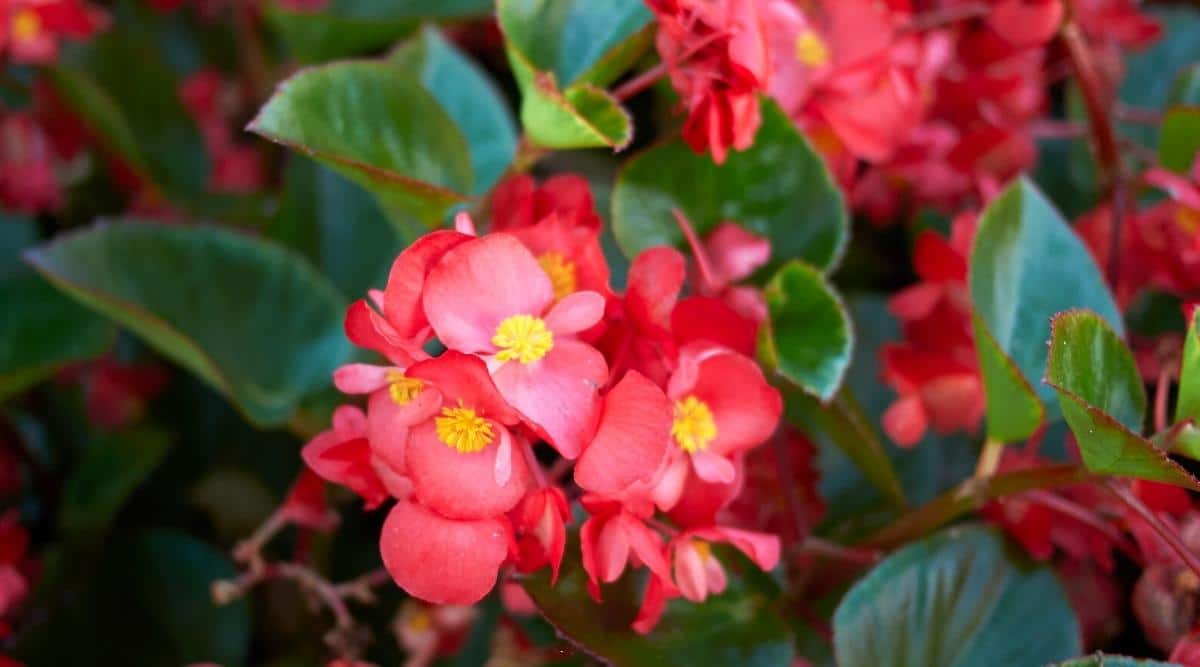Begonia plants have garnered widespread recognition for their stunning attributes, including vibrant and colorful leaves, as well as clusters of eye-catching blooms in shades of pink, red, yellow, orange, or white. These remarkable plants are cultivated as tropical tender perennials, bedding annuals, and houseplants. Among the popular varieties are wax begonias, tuberous begonias, and rex begonias, known for their blooming period spanning from summer to fall. With proper care, certain begonia cultivars and hybrids can even bloom indoors throughout the year.
The genus Begonia, belonging to the family Begoniaceae, encompasses an impressive array of approximately 2,000 distinct varieties of flowering plants. Furthermore, thousands of additional begonia hybrids and cultivars have been developed to create captivating patterned foliage and abundant, brilliant blooms.
For a comprehensive guide on the various types of begonias, this article provides valuable insights. It offers descriptions and images of begonia flowers and leaves, allowing you to identify different begonia species. Additionally, you’ll discover the best begonias for indoor cultivation and which varieties thrive outdoors in your specific region.
Do Begonia Plants Like Sun?
Begonias exhibit their best growth in areas with partial shade. They thrive when exposed to filtered sunlight and find their home in gardens. It’s important to note that the beautiful, thick leaves of begonias can be susceptible to damage from direct and intense sunlight. In fact, begonias with darker leaves tend to prefer sunnier conditions.
For indoor cultivation, it is advisable to place begonias in a bright room while ensuring they are shielded from direct sunlight. Ideal locations include east-facing or west-facing windows for potted begonias. If the plant is situated near a south-facing window, it is beneficial to protect it with a sheer curtain to filter the sunlight. Partial shade and north-facing rooms are also suitable environments for the successful growth of begonias.
Is Begonia Annual or Perennial?
In USDA zones 10 and 11, begonias are delicate perennials. These plants flourish in shaded or lightly sunlit areas, particularly in tropical and subtropical regions throughout the year. However, in colder climates, begonias may experience dormancy during winter and resurface once spring arrives.
Although many people view begonias as annuals, treating them accordingly, they are actually vulnerable to frost. Extreme cold can cause damage to the roots and foliage of begonia plants.
If the temperature drops below 50°F (10°C), one option to protect begonias is to transfer them to containers and bring them indoors for overwintering. For tuberous begonias, you can dig up their corms (tubers) in autumn and store them in a cool and dry place during winter. Once the risk of frost has passed in spring, you can return the tubers to your garden.
Are There Cold-Hardy Begonias?
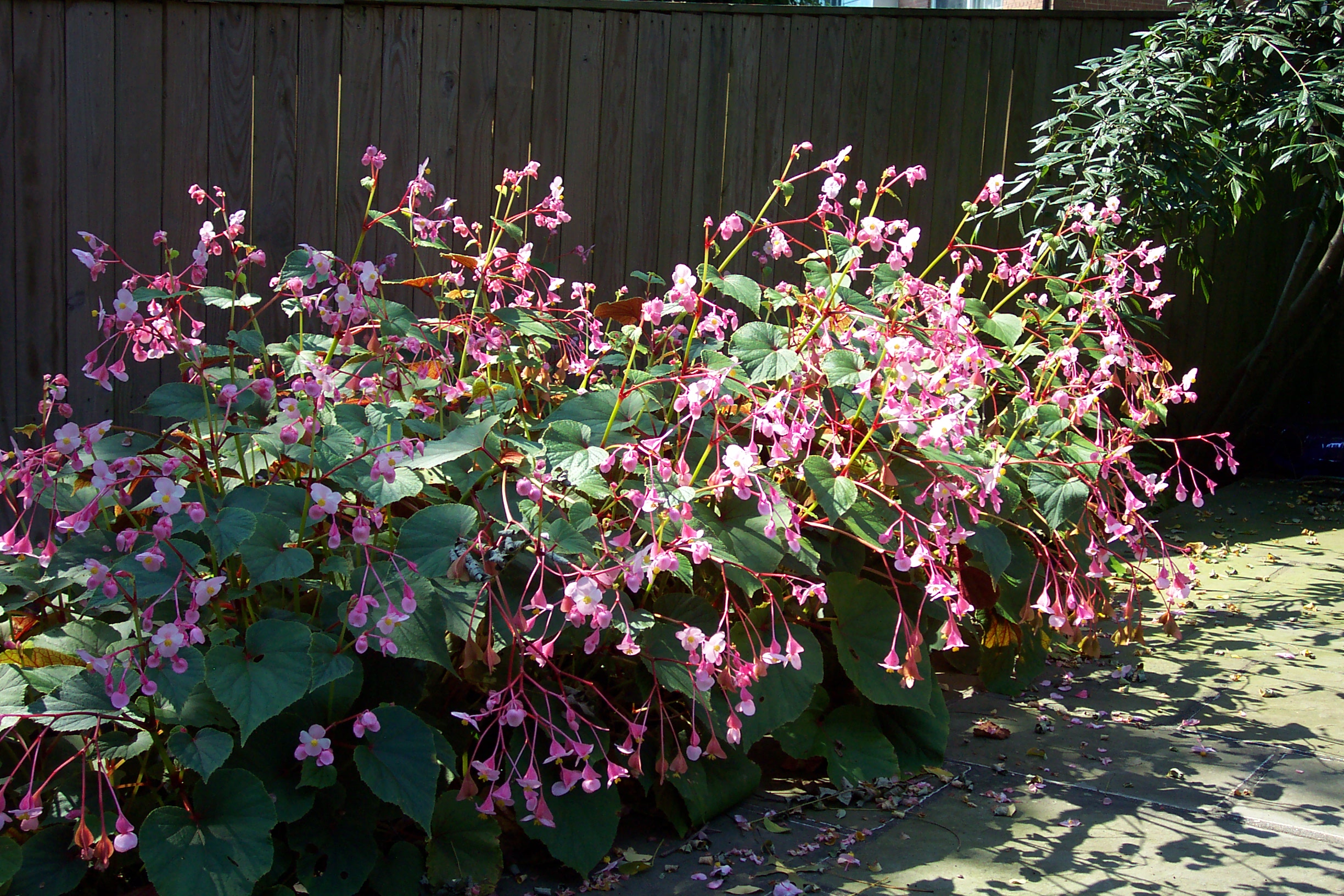
Begonia grandis is the only variety of begonias that can withstand even the most severe winters.
The optimal range for hardy begonias is USDA zones 6 to 9. These tuberous begonias have broad green leaves resembling wings, with crimson undersides. They prefer shade and are perennials. The plants showcase their beauty with tiny pink flowers hanging from slender reddish-red stems.
Cold-hardy begonias can grow to a height and width of up to 24 inches (60 cm).
Among the cold-hardy begonias, there are notable varieties such as Begonia grandis ‘Alba,’ which displays delicate white flowers, and Begonia grandis ‘Torsa,’ featuring large, broad leaves adorned with clusters of pink flowers
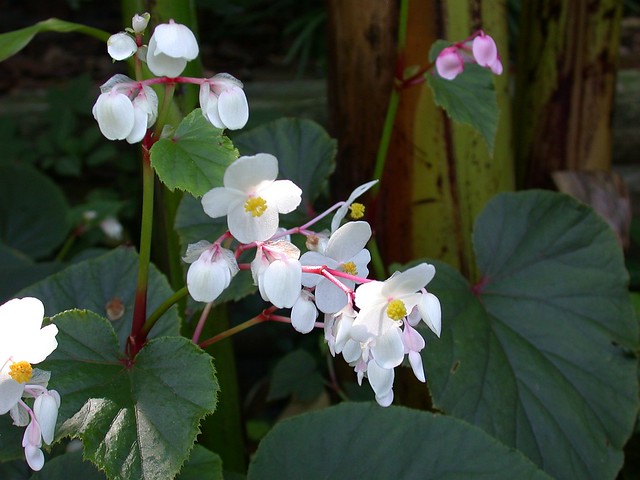
What are Strawberry Begonias?
A plant that resembles a begonia but belongs to a different genus is Strawberry Begonia (Saxifraga stolonifera). The fact that it grows and spreads like strawberry plants gives it the name “strawberry begonia.” The plant is also known as a begonia because of its showy, broadly heart-shaped leaves.
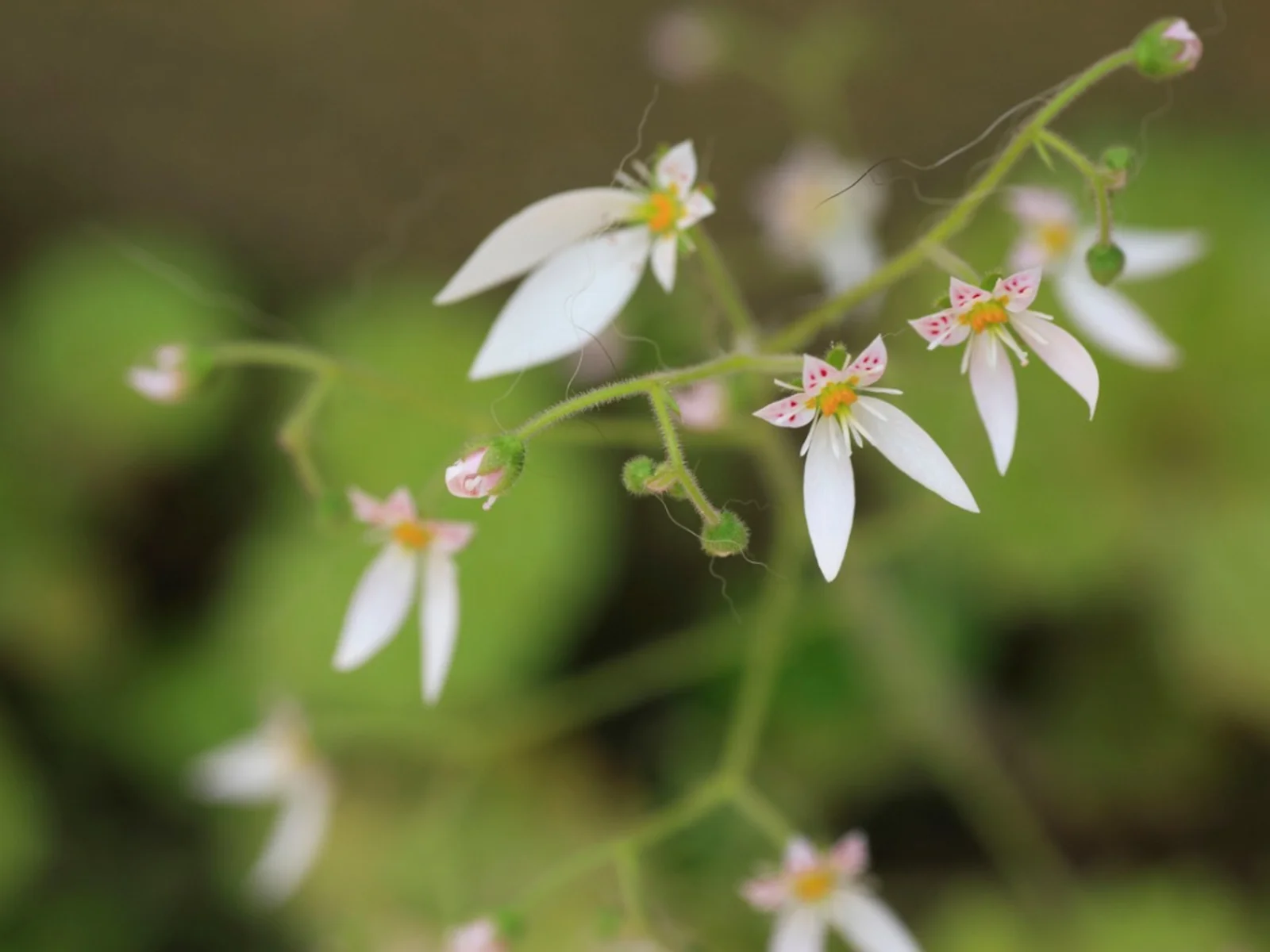
Types of Begonia Colors
Begonia plants are popular due to their colorful leaves and vibrantly colored flowers.
The top of the Begonia leaf is usually light to dark green. The upper sides of certain begonias, particularly brilliant rex begonias, include intricate patterns in silvery hues. Purple, red, green, and pink begonia leaves with a pointed heart-shaped appearance can be found. Begonia leaves have a characteristic that they may have crimson undersides.
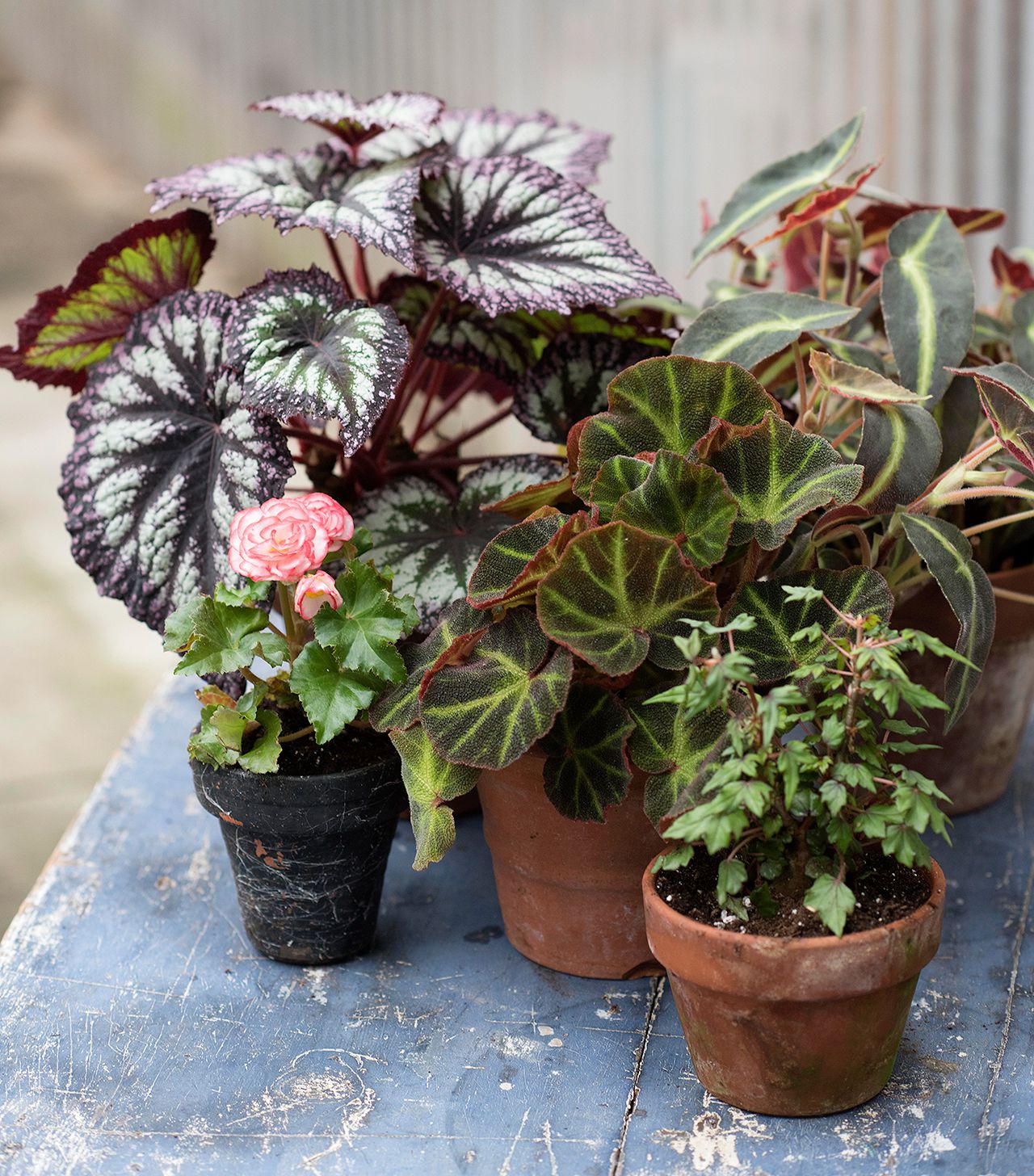
Begonia flowers exhibit a vibrant array of colors, often showcasing variegated shades of pink and red. These charming blooms also come in a diverse palette, including hues of yellow, orange, white, and peach. The begonia flowers are known for their captivating clusters of single or double blossoms, adding a delightful burst of color to any setting.
For optimal leaf and flower coloration in begonias, it is essential to provide the plants with indirect sunlight, allowing them to thrive and showcase their best colors.
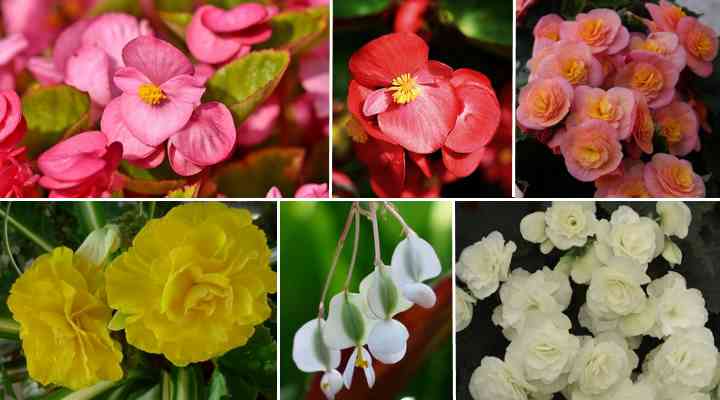
Common Types of Begonia (With Pictures) – Identification Guide
Begonia varieties and hybrids are generally classified into several types, despite the fact that there are thousands of them. Certain hybrids are made up of two distinct types of begonias, while other cultivars come from the same species.
The most prevalent sort of begonia varieties is wax begonias (Begonia semperflorens). The plants have dark green waxy leaves and white, pink, or red blooms. They are usually grown as annuals. Hanging baskets, beds, and planter cultivation of wax begonias are all common. These begonias grow to be 6 to 12 inches (15 to 30 cm) tall and are small plants.
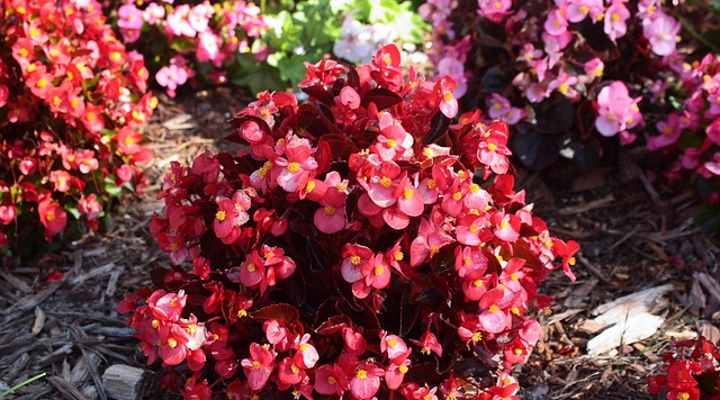
Cane begonias are characterized by their robust, thick stems that grow in a straight manner. What sets them apart are their distinctive wing-shaped leaves adorned with charming polka dot patterns, as well as a wide range of colorful blossoms. Cane begonias encompass various species, such as angel wing and dragon begonias. When cultivated indoors, they typically reach a height of 12 inches when potted, while outdoors they can grow as tall as 5 feet (1.5 meters).

The roots of Rhizomatous Begonias are thick and meaty, and they’re cultivated for their leaves rather than flowers. Fancy-leaf, king, or painted leaf begonias are popular names for these begonia cultivars and hybrids. The fuzzy leaf texture of rhizomatous begonias may be used to identify them.
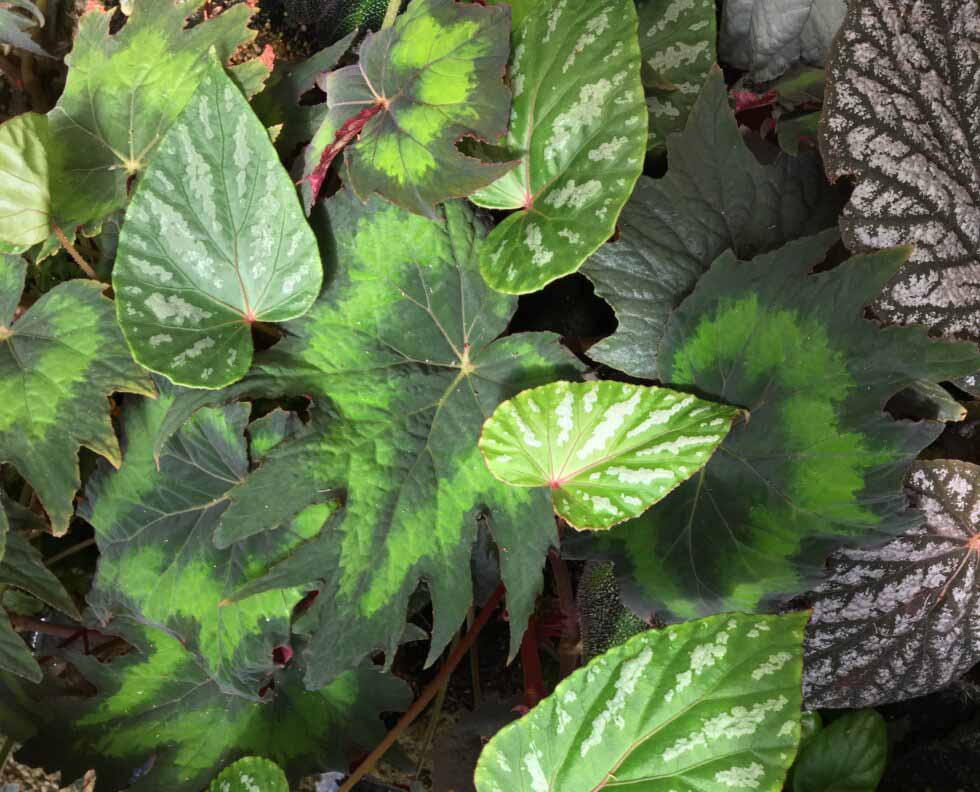
Begonias have gained popularity as indoor plants due to their intriguing pointed leaves adorned with captivating patterns. Bushy begonias, in particular, tend to reach a height and width of about 12 to 18 inches (30 to 45 cm), creating a lush appearance.
Tuberous begonias, commonly referred to as begonia bulbs despite their actual root structure called corms or tubers, produce stunning blooms that are among the most impressive in the begonia family. By digging up and safeguarding the corms during winter, they can be nurtured as tender perennials, allowing for their continuous cultivation.
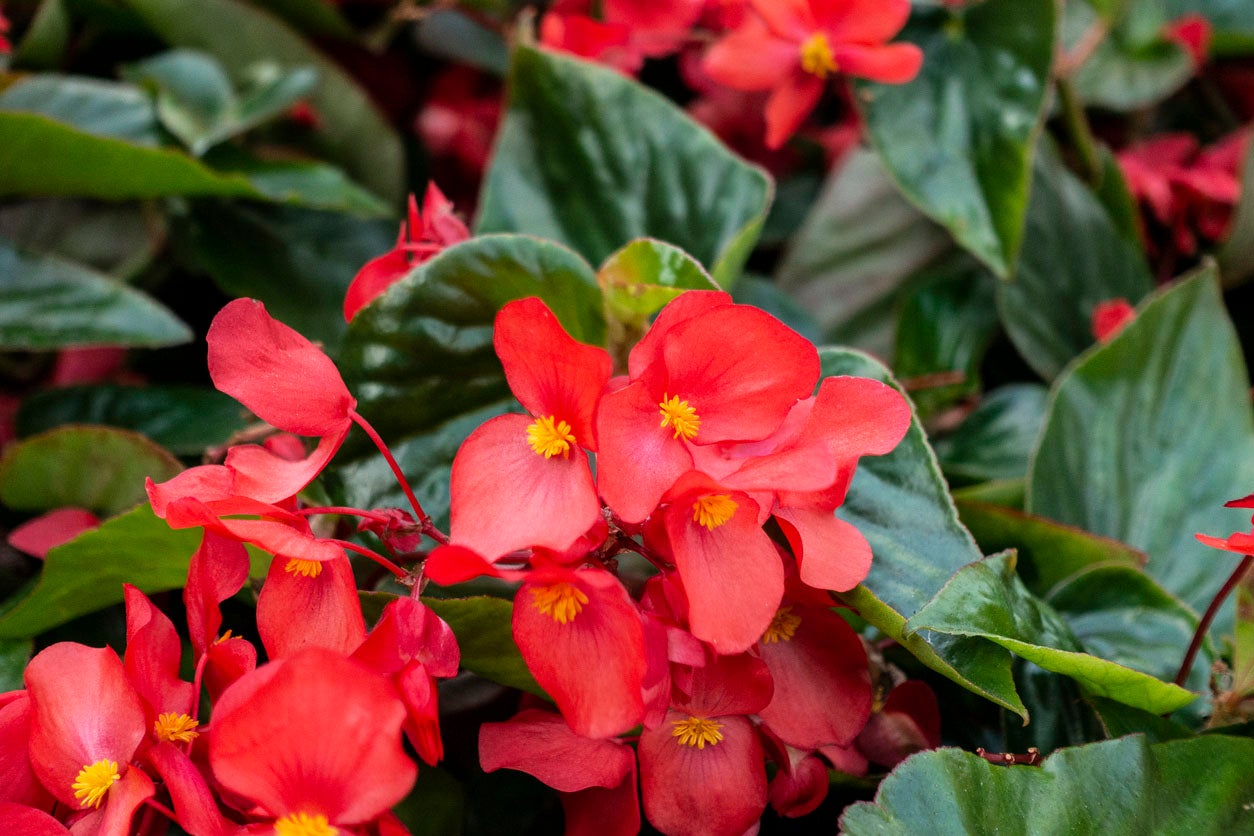
Types of Wax Begonia (Begonia semperflorens-cultorum)
Flowering begonias known as wax begonias are adored for their charming clusters of small, four or five-petaled blooms in shades of red, pink, or white. These begonias are commonly used for bedding displays. One of their notable features is their petite, round or ovate leaves with a glossy wax-like texture. While wax begonias thrive indoors, they are also cold-hardy in USDA zones 10 and 11.
Now, let’s explore a few captivating varieties of wax begonias:
Begonia Ambassador Scarlet
A tiny wax begonia plant with yellow centers and crimson blooms. Little rounded glossy green leaves contrast well with the red oval begonia blossoms. This is a beautiful annual bedding plant in full sun to partial shade that thrives in hanging baskets, containers, and as an annual bedding plant.
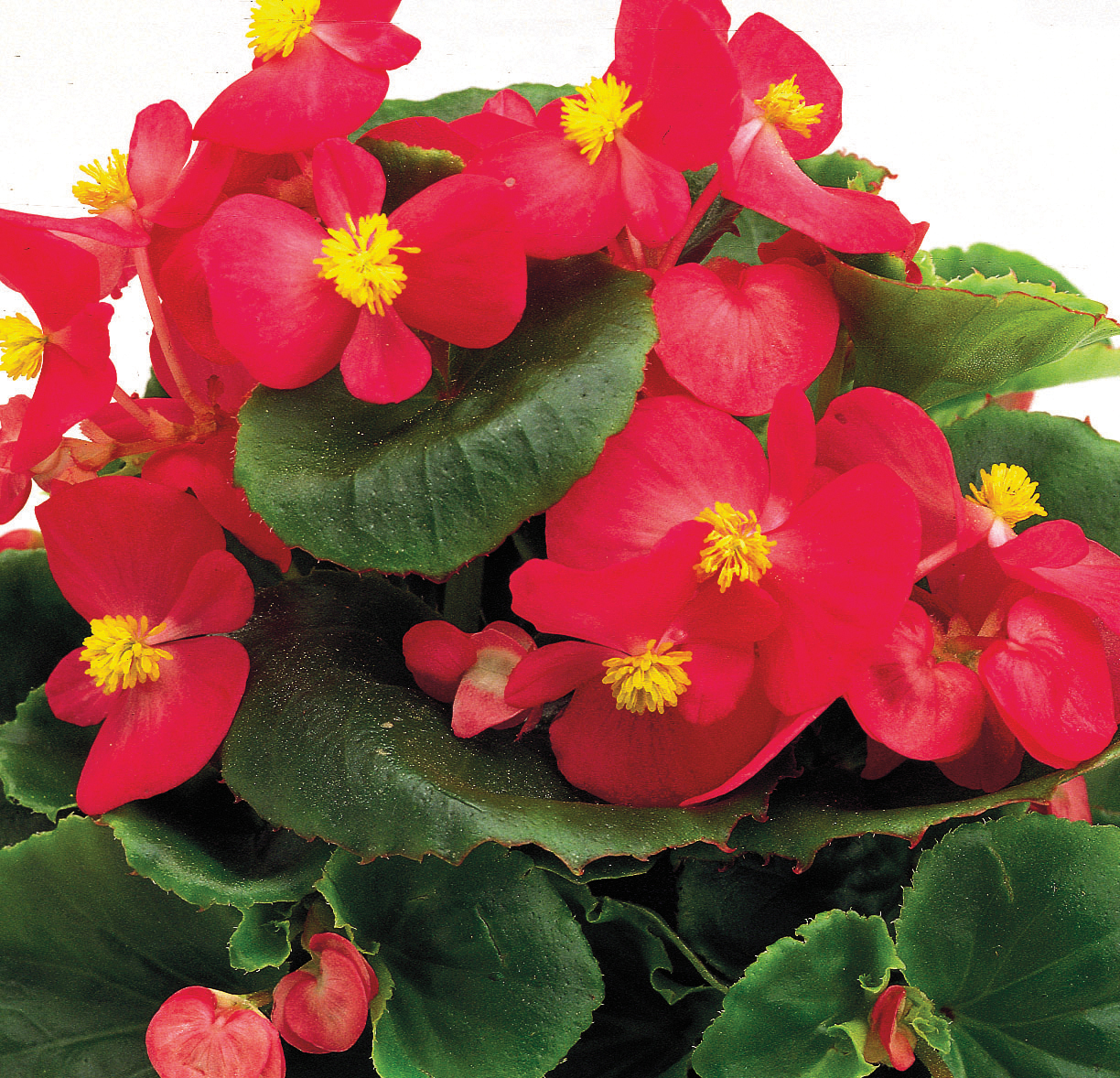
Cocktail Series Wax Begonia
Dark bronze, almost black leaves and fragile clusters of pink, red, and white blooms characterize this kind of fibrous-rooted begonia. The ‘cocktail’ series of begonias may grow up to 6 inches (15 cm). As an annual bedding plant, plant it in window boxes.
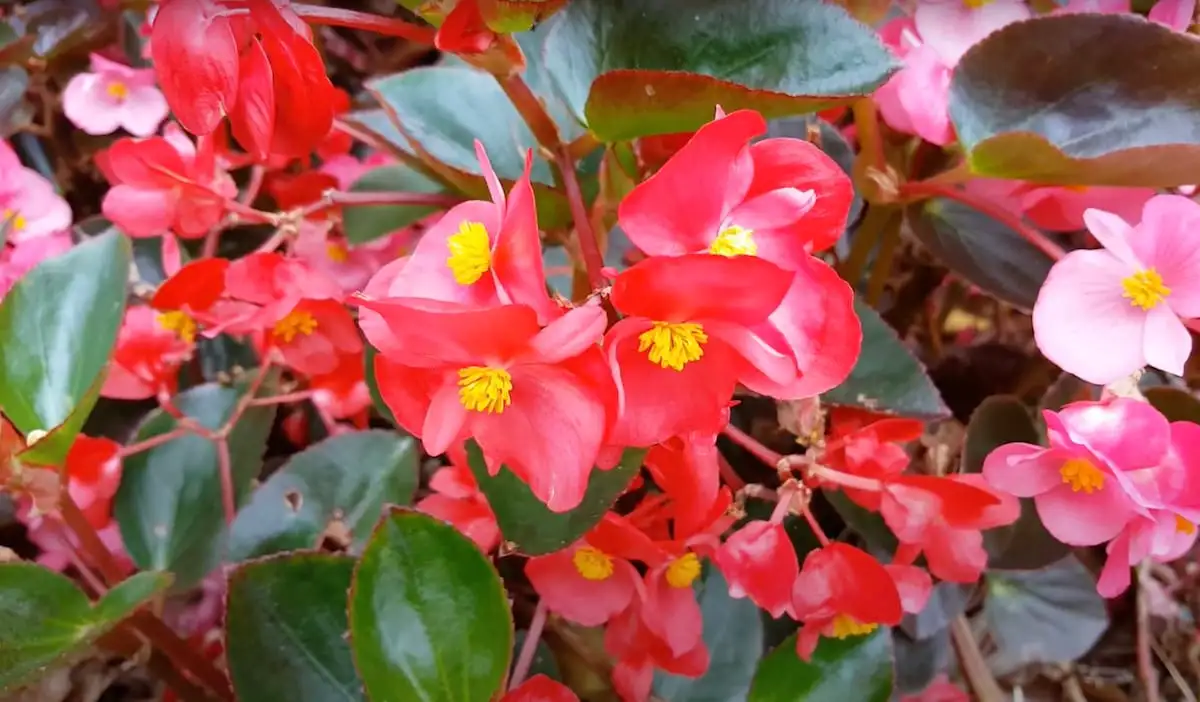
Wax Begonia ‘Party’ Series
Wax ‘party’ begonias tolerate a few hours of direct sun and have large waxy leaves. The crimson edge of the bright green wax begonia leaves matches the scarlet crimson or pinkish-white blooms, giving the foliage a vivid red color. Varieties with double blooms are ideal for spectacular wax begonias. It can grow to be up to 20 inches (50 cm) tall.
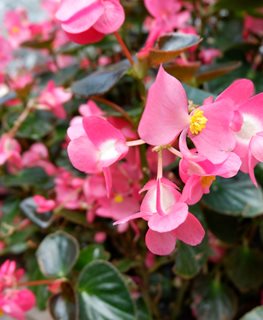
Senator White Wax Begonia
The blossoming of wax begonias brings forth a breathtaking display, with their dark bronze leaves beautifully contrasting against pure white flowers. These begonias belong to the semperflorens cultivar, which is known for its resilience in hot and dry conditions. It is an ideal choice for summer gardens and can be cultivated as an annual plant.
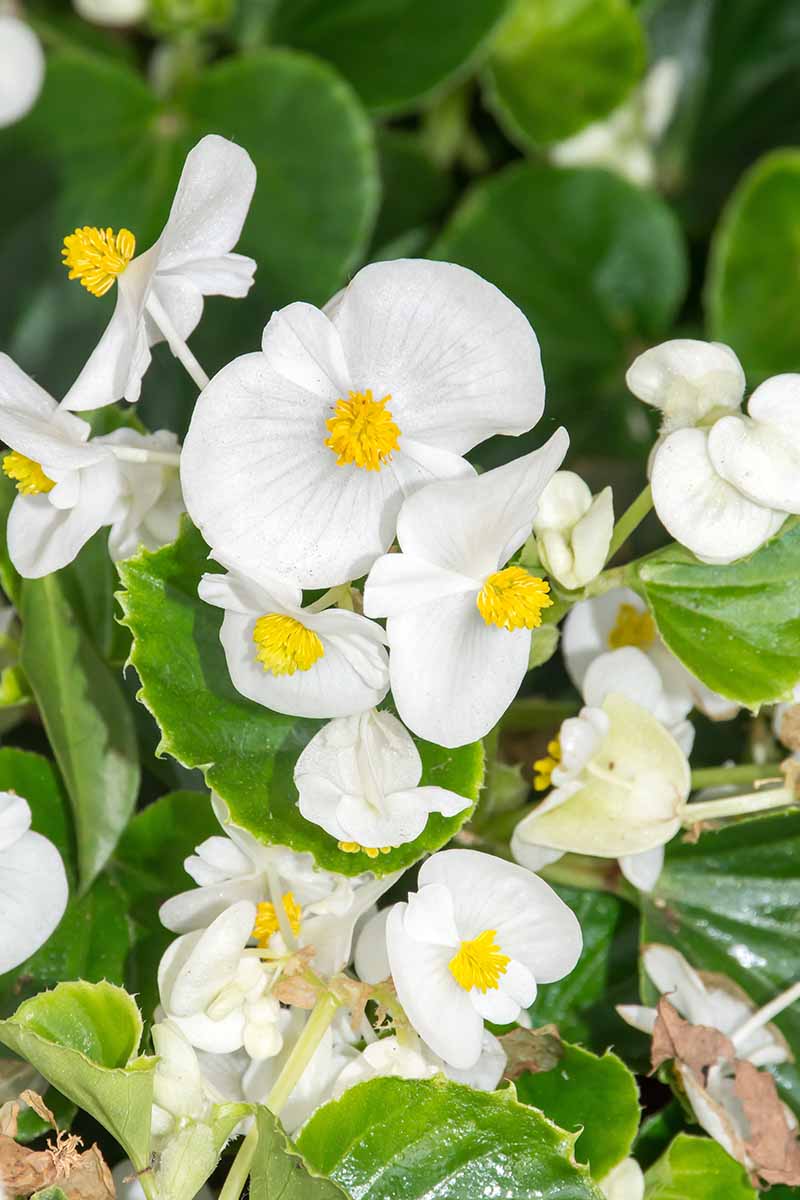
Wax Begonia ‘Doublet Red’
The captivating doublet red wax begonia showcases petite, frilly blooms resembling roses, which stand out beautifully against the glossy bronze-green leaves. The heart-shaped leaves of this succulent begonia variety maintain their dark green hue throughout the year. With a maximum height and width of 12 inches (30 cm), it adds a charming presence to any space.

Types of Angel Wing Begonia (Begonia coccinea x Begonia aconitifolia)
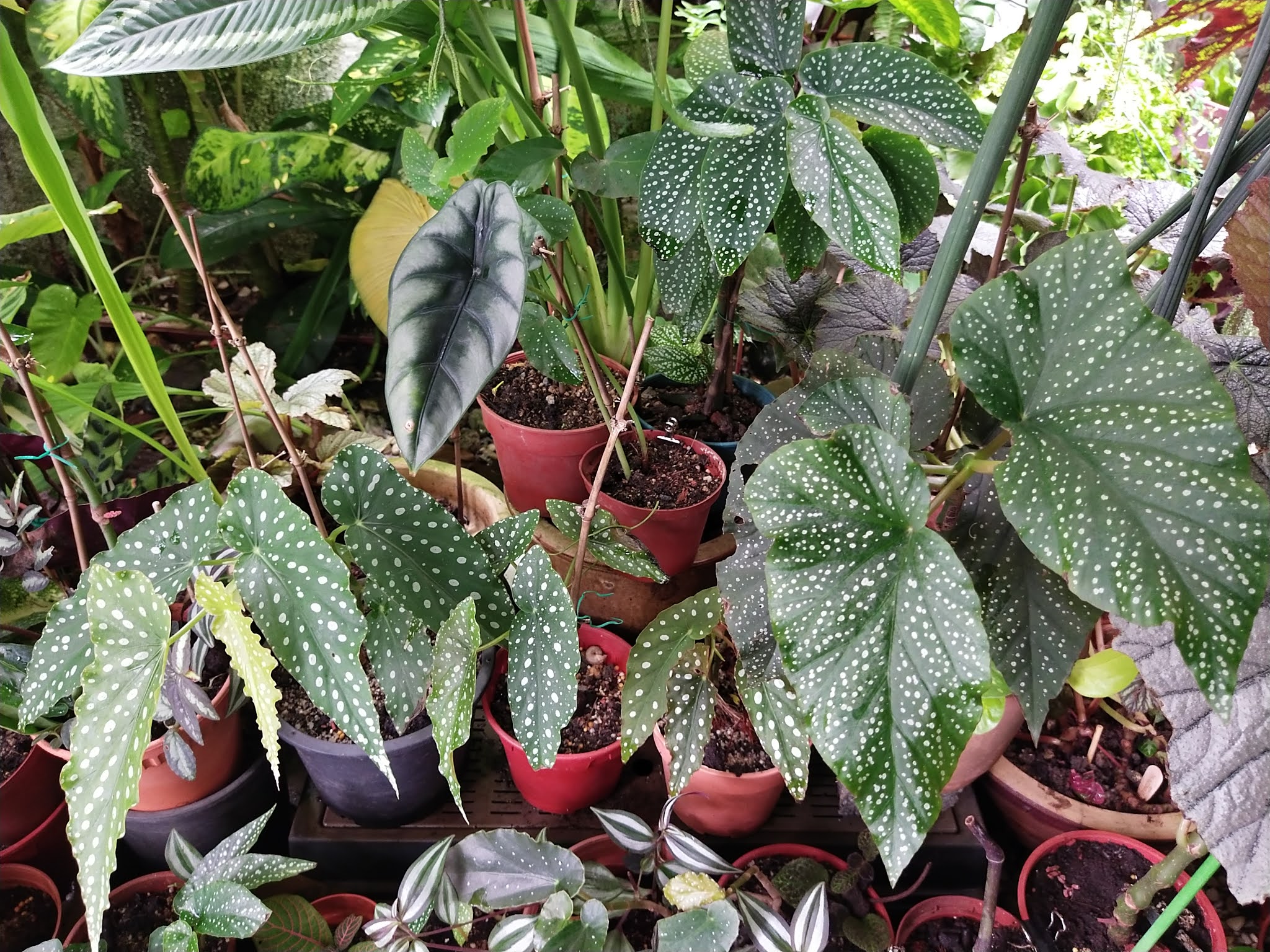
The angel wing begonia, a type of cane begonia, features exquisite wing-shaped leaves adorned with dotted or speckled patterns. This begonia variety displays stunning clusters of small pink, red, and orange flowers that hang gracefully from its red stems. Angel wing begonias are fast-growing plants that can reach a width of up to 24 inches (60 cm) and a height of 12 inches (30 cm).
Many cultivars of angel wing begonias boast leaves with serrated edges and charming polka dot patterns. Even without blooming, the foliage of these begonias remains captivating, making them an appealing indoor plant choice. The leaves can grow to a length of approximately 6 inches (15 cm), adding to their visual interest.
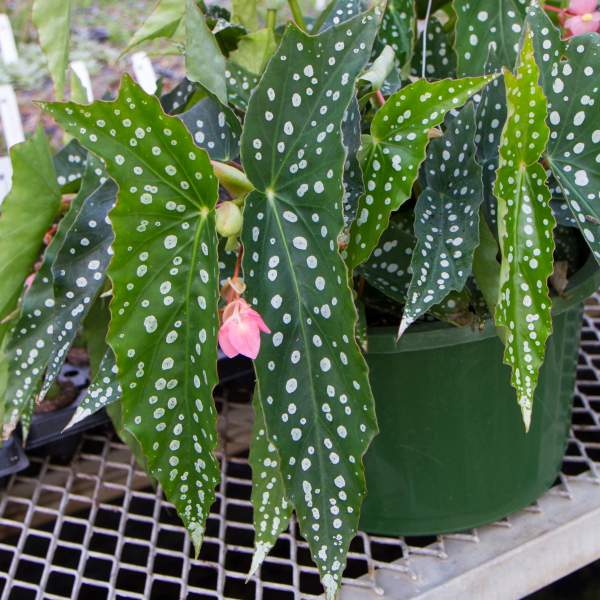
USDA zones 10 and 11 are ideal for angel wing begonias. In general, average room temperatures and humidity are ideal for ornamental begonia. Angel wing begonias are popular hanging basket plants because of their long arching cane-like stems and dangling blooms.

Discover these exceptional hybrids of angel wing begonias:
Begonia ‘Super Cascade’—Prepare to be amazed by the vibrant pink and red flower clusters that gracefully dangle from this angel wing begonia. The showy blossoms are a striking 5 inches (13 cm) in size, creating a captivating visual spectacle.
Begonia ‘Apricot Shades’—This begonia variety showcases some of the largest blooms among all begonias. The stunning peach-colored flowers are so abundant that they almost completely envelop the decorative wing-shaped leaves when in full bloom.
Begonia ‘Million Kisses Elegance’—Delicate pink begonia flowers in elegant clusters enhance the allure of this begonia hybrid. With their drooping oblong shape, these flowers beautifully complement the lush and leafy foliage of the plant.
Types of Rex Begonia (Begonia rex-cultorum)
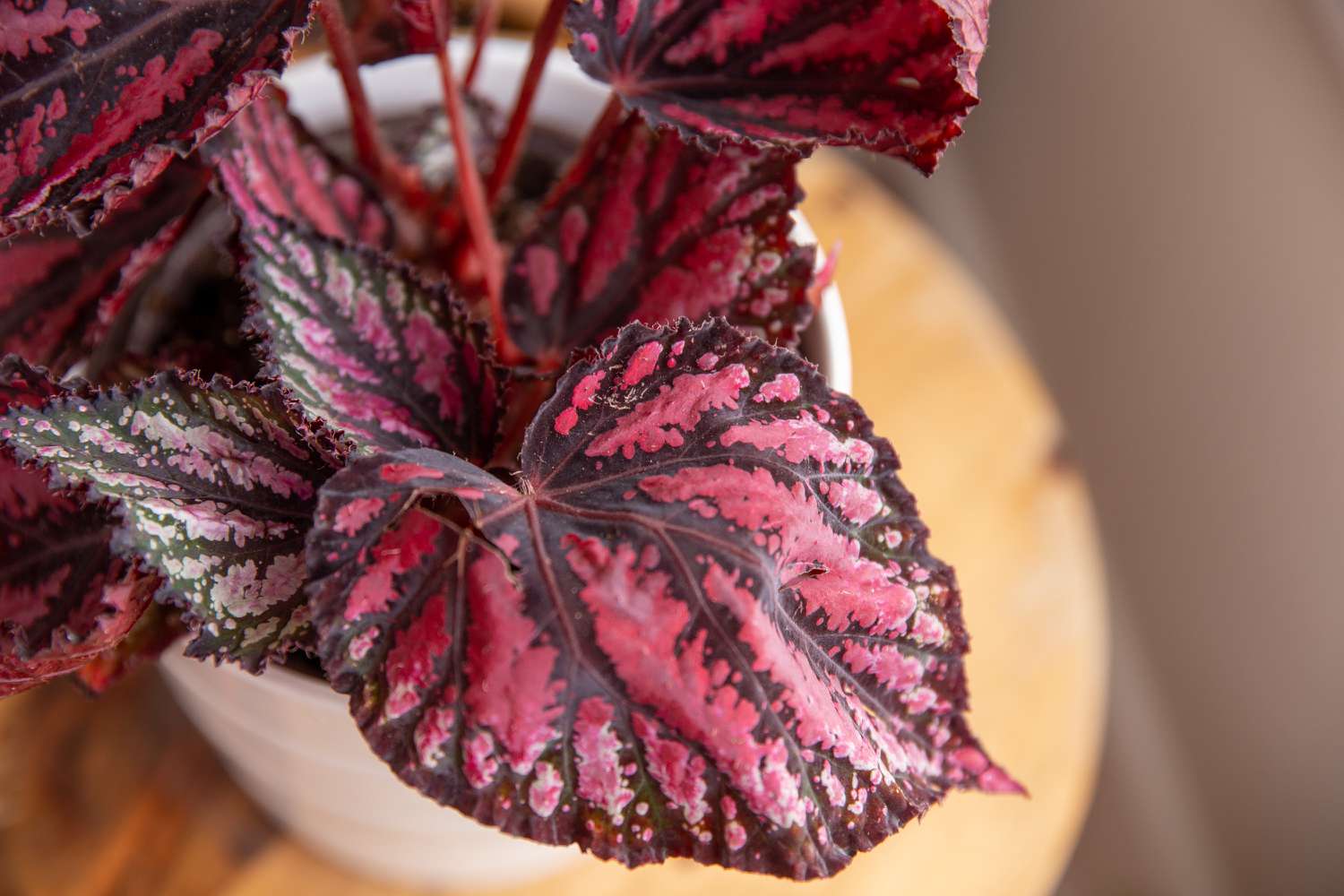
Tuberous begonias encompass various species, and one notable kind is the Rex begonia, renowned for its striking foliage among houseplants. The leaves of Rex begonias display mesmerizing patterns and protruding veins, creating a captivating hazy effect. Some of the most remarkable Rex begonias feature leaves adorned with swirling and intricate designs.
While Rex begonias do produce flowers, they are not primarily cultivated for their blossoms. These plants typically reach a height of 1 to 1.5 feet (30 to 45 centimeters) and have a spreading growth habit.
The leaves of Rex begonias come in an array of captivating colors, including red, pink, silver, gray, purple, and dark green. The heart-shaped leaves often feature a distinct dark-colored border. Certain varieties exhibit silver or gray leaves with contrasting black veins, while others boast speckled patterns reminiscent of splattered paint.
Now, let’s explore a few stunning types of Rex begonias:
Begonia rex ‘Zurich’
Rex begonias have dark burgundy, pink, green, and silver colors that mimic caladium leaves in their vivid pointed leaves. Green edges, pink and silver designs, and black veining in the centre characterize the begonia’s heart-shaped leaves.
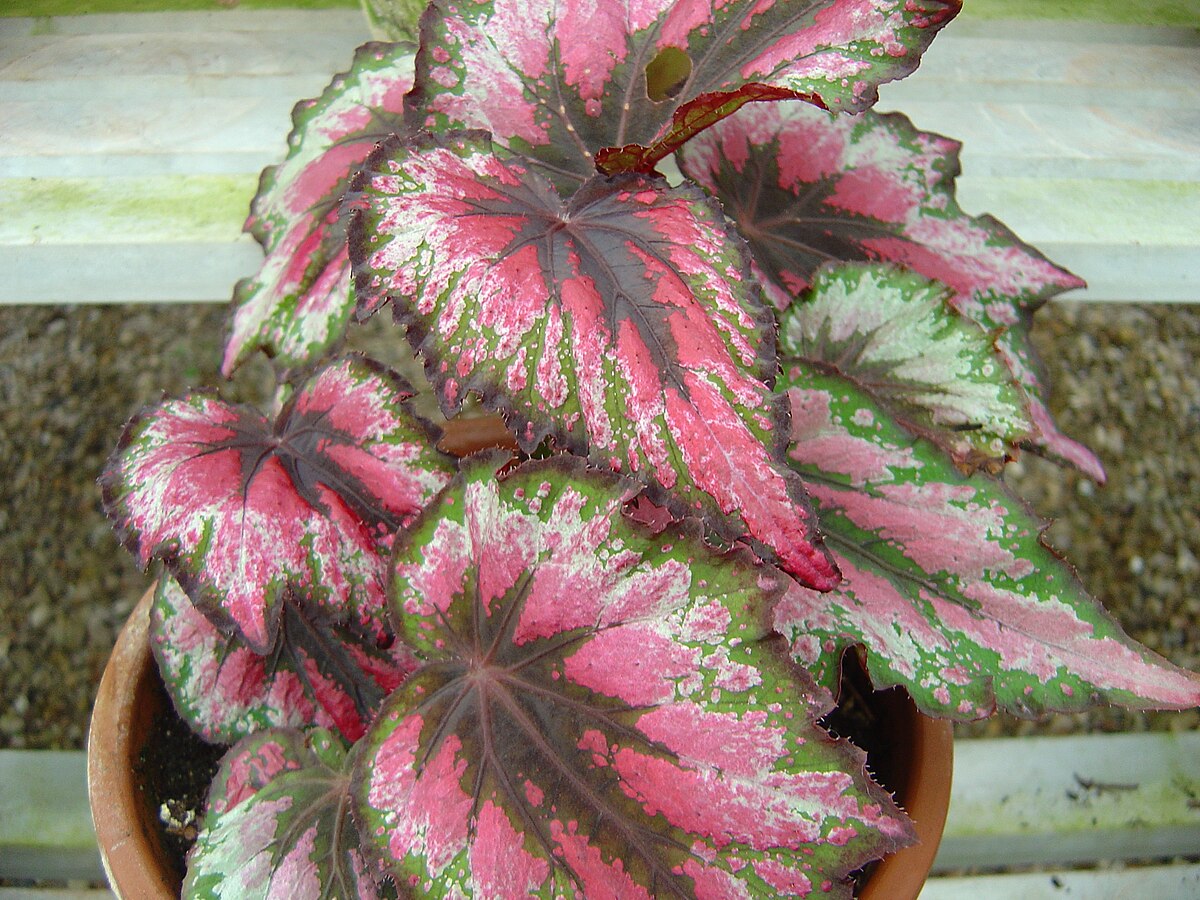
Begonia rex ‘Paul Gibory’
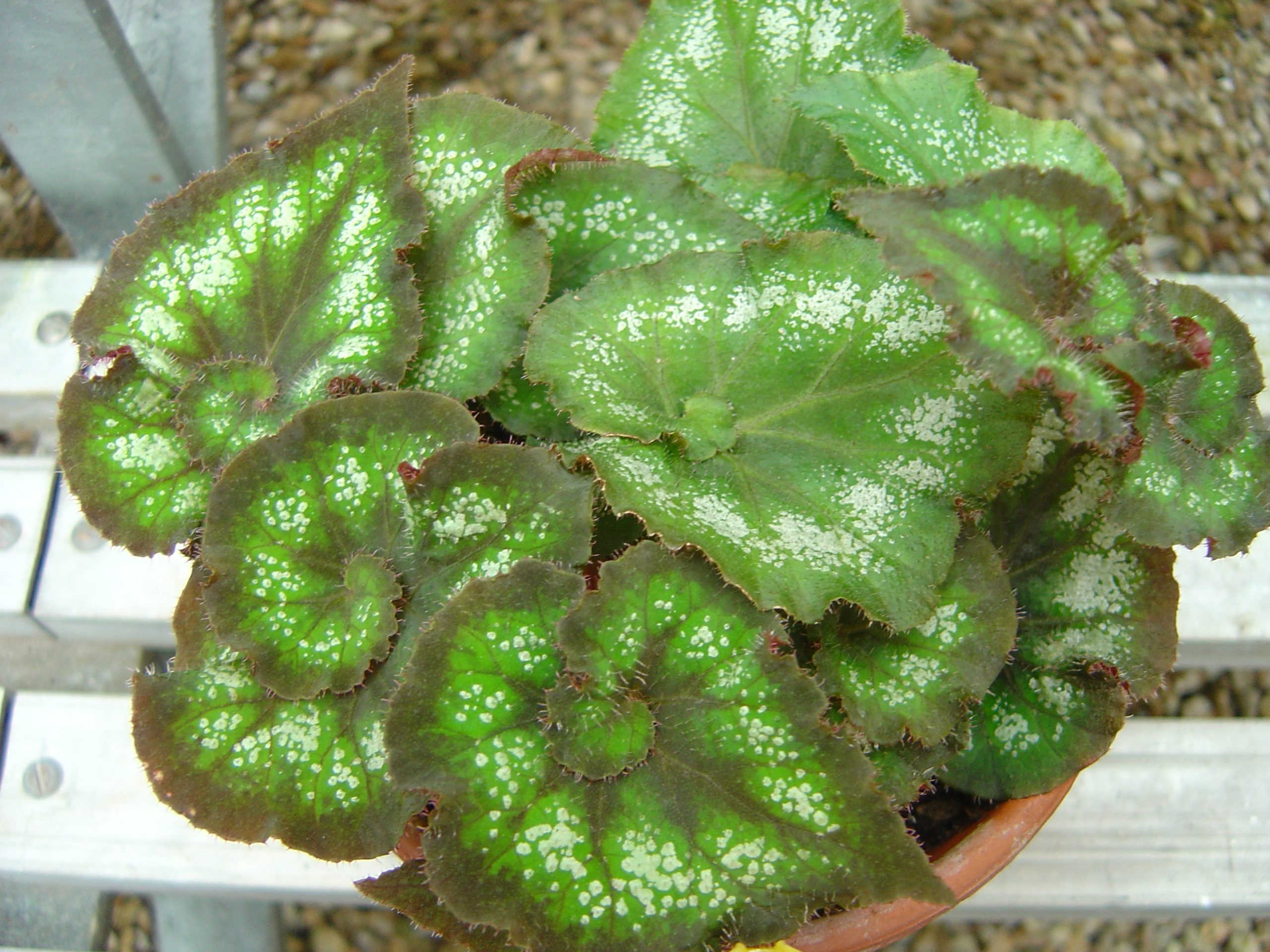
Begonia rex ‘paul gibory’ has pointed heart-shaped leaves with sharp lobes and tiny hair-like projections along the margins. There is a dark maroon center with green leaf margins surrounding pink and lilac hues.
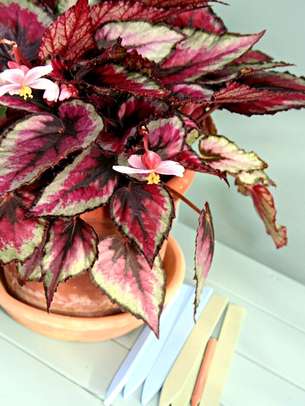
Painted-leaf rex begonia
The oval leaves have spiral patterning and are also known as King Begonia. The leaves are light green with a fuzzy feel and pinkish edges.
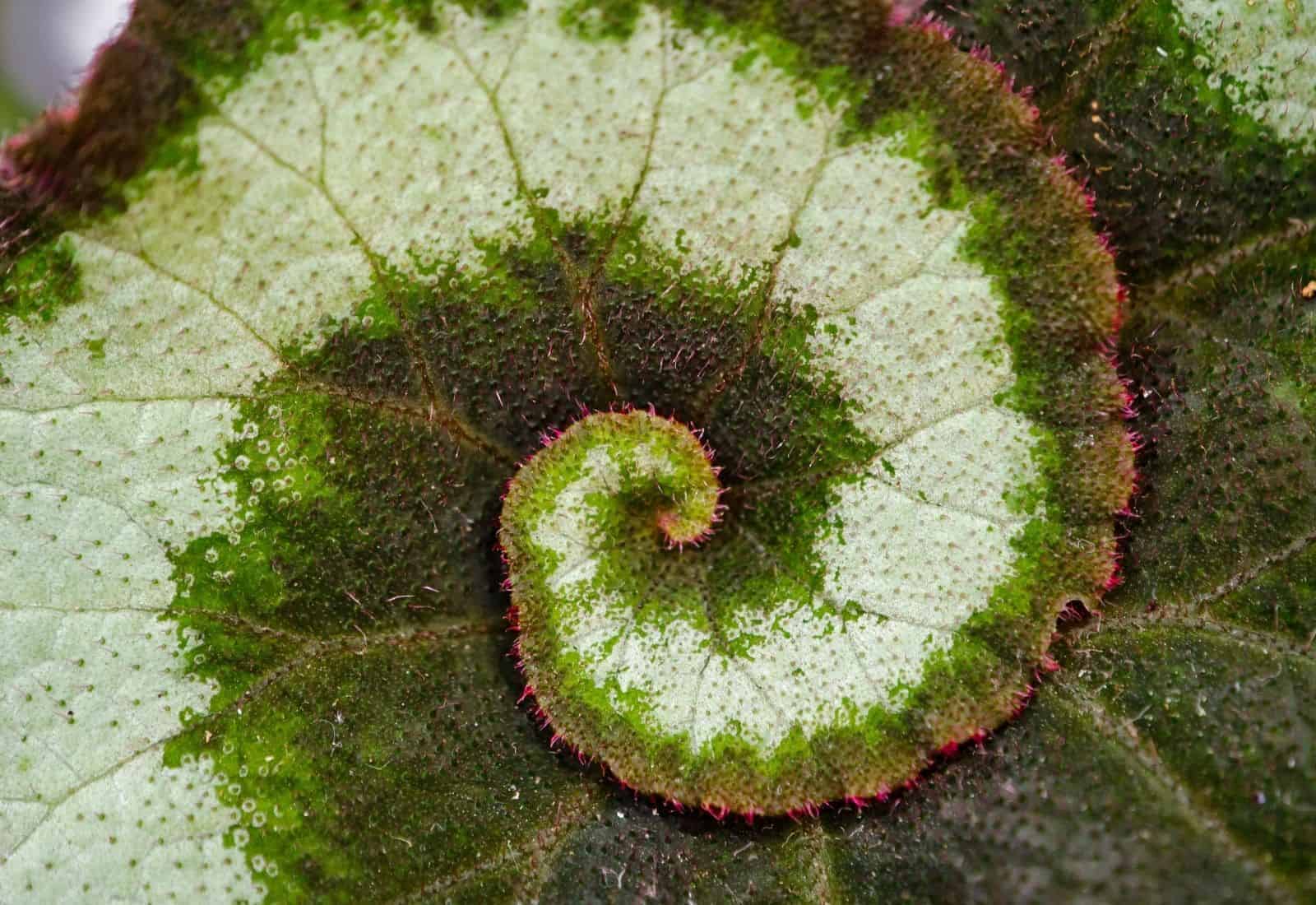
Rex begonia hybrid ‘J Gillinwators’
Delicate pink blooms with four petals emerge on bright red stems when this rex begonia hybrid blooms.

Rex begonia hybrid ‘Merry Christmas’
The leaf surface of this rex begonia is slightly fuzzy and has vivid lime-green leaves with prominent reddish-maroon veins.
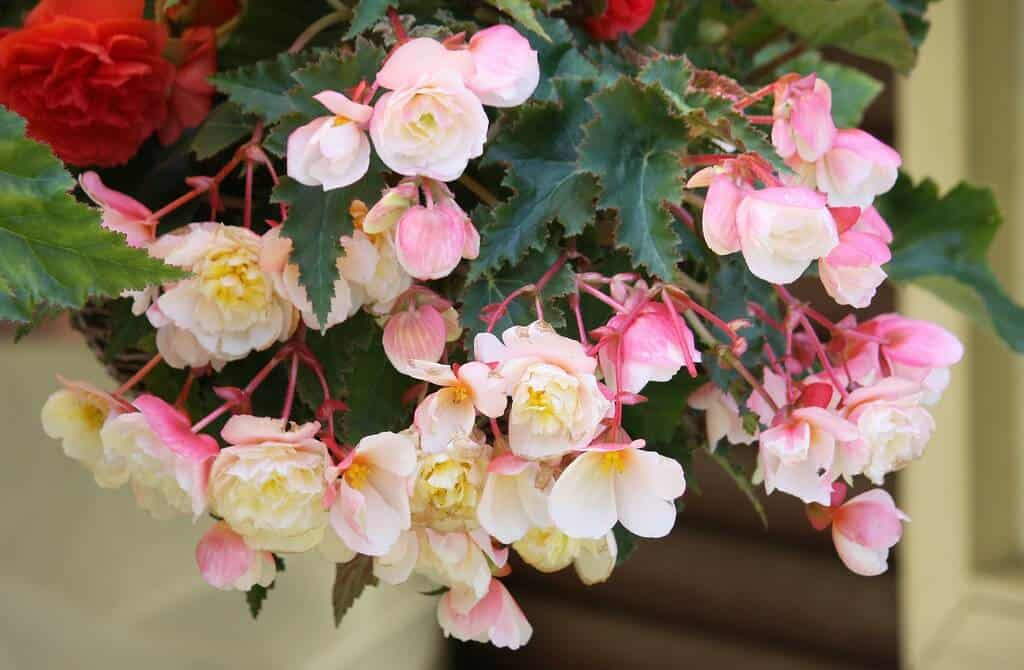
Other Types of Begonias (With Pictures) – Identification Guide
Polka Dot Begonia (Begonia Maculata)
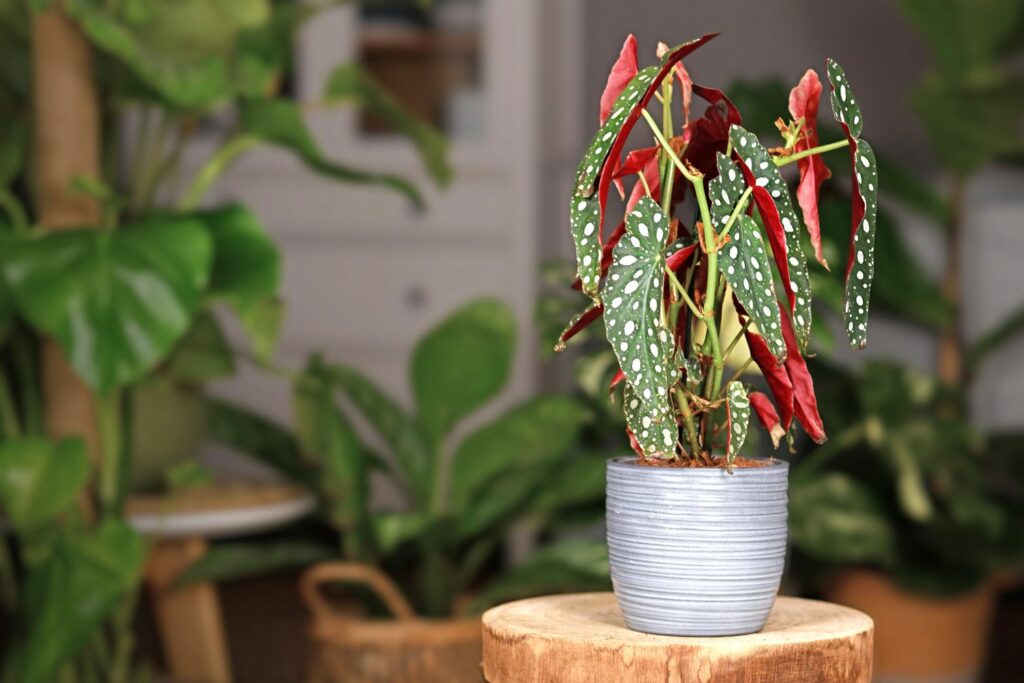
The polka dot begonia is characterized by its distinct wing-shaped leaves that have a unique asymmetrical and pointed appearance. What truly makes them captivating is their magnificent coloration. Each green leaf of the begonia is adorned with polka dot designs, resembling speckles of paint. The underside of the leaf features a reddish-purple hue, adding further allure.
When the polka dot begonia blooms, it produces charming white or pink flowers with delicate yellow stamens. These blossoms add an extra touch of beauty to the plant.
As a cane begonia, the polka dot begonia thrives when grown in containers, making it well-suited for typical household conditions. It has the potential to grow up to 5 feet in height, as evident from the towering leaves it possesses.
Dragon Wing Begonia (Begonia x hybrida ‘Dragon Wings’)
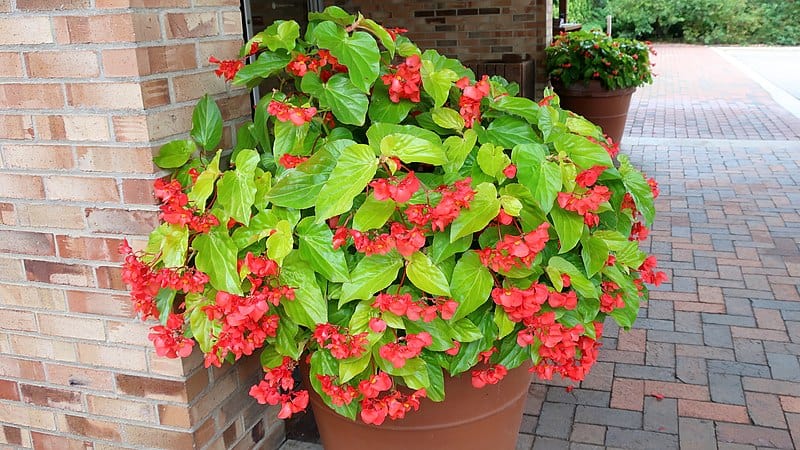
The dragon wing begonias exhibit lush and glossy foliage accompanied by clusters of vibrant red or pink blooms. The leaves of dragon wing begonias resemble those of angel wing begonias, reaching a length of approximately 8 inches (20 cm). These begonias typically grow to a height of around 2 feet (0.6 meters), adding a noticeable presence to any space.
It’s common for angel wing begonias and dragon wing begonias to be mistaken for one another. However, a key distinguishing factor lies in their leaves. Unlike most angel wing begonias, dragon wing begonias do not possess polka dot patterns on their foliage.
Dragon wing begonias showcase exceptional tolerance to heat and drought conditions, surpassing many other begonia cultivars in this regard. Their ability to withstand such conditions makes them a resilient choice for various environments.
Rieger Begonia (Begonia × hiemalis)
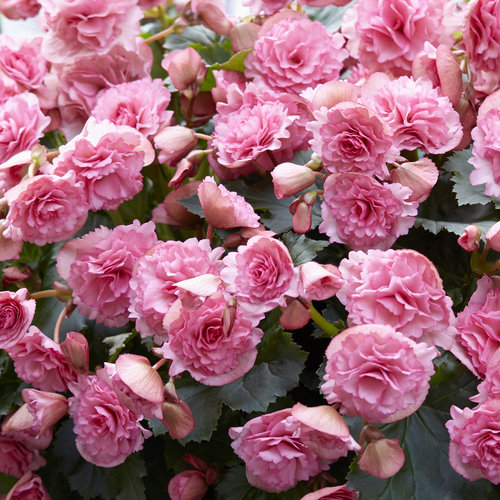
Reiger begonias, also referred to as Elatior begonias, boast dark green leaves with serrated edges. These leaves provide an exquisite backdrop to the clusters of dainty blooms that come in various hues, including delicate pink, red, yellow, or orange. When cultivated as houseplants, Reiger begonias create a stunning display with their compact growth habit.
The Begonia hiemalis, a type of Reiger begonia, typically reaches a height of 12 inches (30 cm) and a width of 15 inches (38 cm). Its vibrant foliage and charming blossoms make it an attractive choice for indoor gardening.
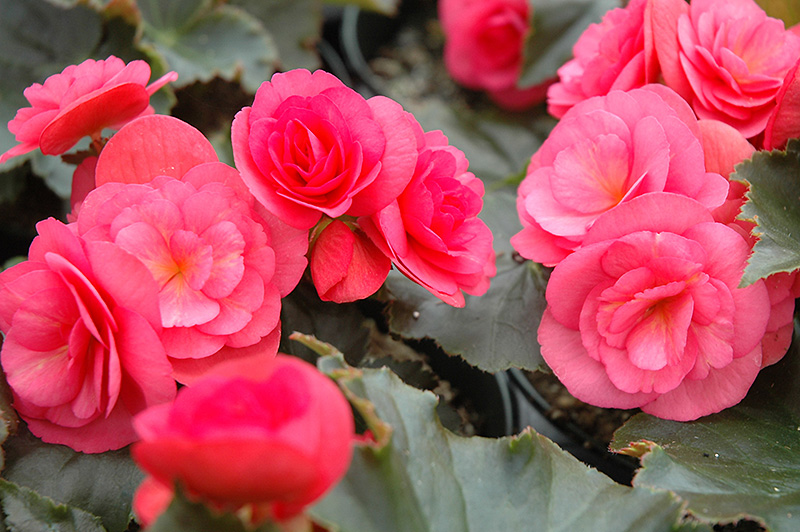
Tuberous Begonia (Begonia × tuberhybrida)

Tuberous begonias are known for their exceptionally beautiful blooms among all begonia species. These begonias produce large, rose-like flowers in striking shades of yellow, white, red, and orange, adding a burst of color to late summer and early fall. Whether grown in window boxes, hanging baskets, planters, or mixed flower beds, tuberous begonias are a sight to behold.
Here are a few noteworthy types of tuberous begonias that showcase large, double rose-like flowers:
- Begonia ‘Sunpleasures Apricot’
- Begonia ‘Patio’ series
- Begonia ‘Illumination’ series
- Begonia ‘Non-Stop Joy Mocca White’
Each of these varieties offers its unique charm and contributes to the overall allure of tuberous begonias.
Boliviensis Begonia (Begonia boliviensis)
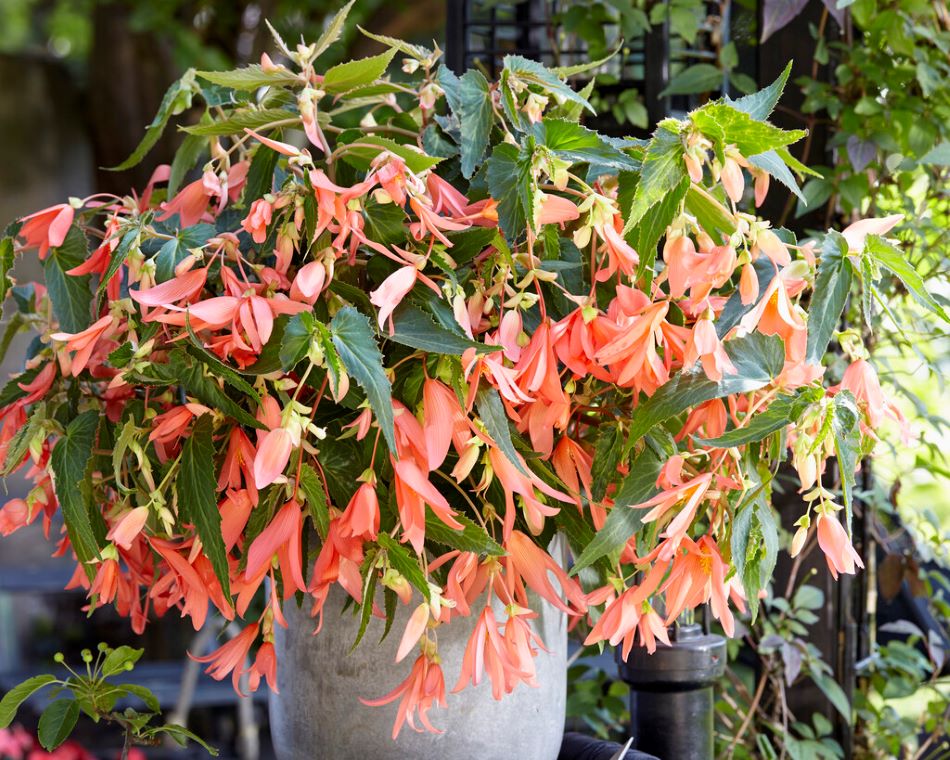
Boliviensis begonias are a variety of begonia with tuberous roots, characterized by their lanceolate leaves and tiny blooms that dangle delicately, featuring five oblong petals. One of the notable traits of Boliviensis begonias is their long, cascading stems adorned with fiery-red or orange flowers, which adds to their allure.
The trailing stems of these begonias typically measure 12 to 16 inches (30 to 40 cm) in length, with a spreading range of 16 inches (40 cm). Boliviensis begonias thrive in environments with indirect light or partial shade, making them ideal for hanging baskets. When placed in large containers or sunny window boxes, the scarlet blooms cascading over the edges create a lovely sight.
Boliviensis begonias are known for their heat and drought tolerance. With sufficient sunlight, they will bloom throughout the summer season until the arrival of frost, showcasing their resilience and beauty.
